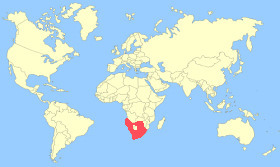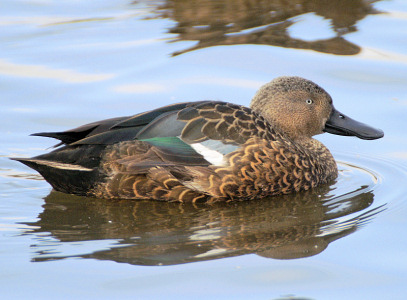Appearance:
Male - The male Cape Shoveler has a speckled blackish crown and hindneck, a pale grey-buff face and throat, yellow eyes, a large black spatulate beak, a reddish-brown body with light-buff feather edges giving a mottled appearance, a green-black rump and uppertail, tertials and scapulars are a glossy blue-black, the primary wing feathers are brown, the forewing is pale blue, the speculum is metallic green-blue with a white border, and the legs and feet are yellow-orange.
Female - The female is similar but has a dull brownish and more mottled appearance, a darker head, brown eyes, a dark brownish-grey spatulate beak, the wings are greyish, and the legs and feet are a greyish-yellow.
Size: - Typical Adult is 51-53cm (20-21in).
Food: - Crustaceans, molluscs, insects, also aquatic plants and seeds. The large spatulate beak is used to filter aquatic invertebrates and insects from the water.
Habitat/Range: - Open, fresh and brackish wetlands, lakes, marshes, estuaries, and coastal lagoons in South Africa, Namibia, Botswana, Zimbabwe, southern Angola, and southern Zambia.

 Breeding Habitat/Resident,
Breeding Habitat/Resident,  Migration or Winter Area.
Migration or Winter Area.Breeding Season: - Mainly August to December but variable depending on water levels and food.
Eggs: - 5 to 12 (creamy with greenish tint).
Notes: - The Cape Shoveler is a South African dabbling duck. It is non-migratory but undertakes some local seasonal movements. The Cape Shoveler can be mistaken for a vagrant female Northern Shoveler but the Cape Shoveler is much darker and stockier.
Conservation status (IUCN 3.1):
Least Concern.
Classification: - Family: Anatidae,
Subfamily: Anatinae, Genus: Anas.



 photo by Neill Smith.
photo by Neill Smith.
